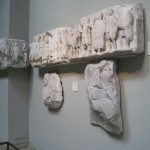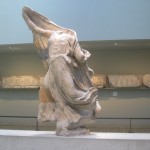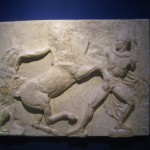After all of this time spent in museums in London, especially the British Museum, I find myself asking just one question: How are they still allowed to keep this kind of stuff? I mean, I can’t exactly speak for the Greek government, but I imagine that they would want the sculptures taken from likely the most important structure in Ancient Greek history back. Oh wait, Yes I Can. Despite the fact that England’s age of Imperialism is most certainly gone and past, it is peculiar and almost funny to see that certain citizens of Britain are still holding to the imperialist mentality decades after their actual country gave it up.
In 1801, the Earl of Elgin decided that in order to prevent pieces of the Parthenon from being burned to obtain lime, he was going to excavate pieces of the temple and its sculptures to put under his protection. The only problem is that in order to protect them, he took them out of the country and sold them to the British Museum. Masked under the cause of protecting cultural artifacts, it is apparent today that it was nothing more than a trophy to liberate from Greece and its people. In fact today the term elginism means the practice of plundering artifacts from their original setting. So why is it that despite Greece’s continuous calling for the return of these artifacts that are rightfully theirs, England seems reluctant to give them up?
The answer seems to lie with everyone’s favorite blog topic: identity. There are some opinions that state that as a center of world heritage, Parthenon sculptures are better off in the British Museum that in the actual Parthenon. This probably would have been a valid argument at around the time that the marbles were actually stolen, but is laughable today. Playing the role of cultural center of the world, British supporters insinuate that Greece is in some sort of corner of the planet that doesn’t see anyone other than its inhabitants. This is the 21st century. There are few people who live in Europe who cannot in a moment’s notice hop on a plane and be in Greece within a 24 hour period. The truth behind the matter is that there are those in Britain (mostly likely A.N. Wilson is one of them) that yearn for the time that their country moved and shook the very foundations of the planet with its actions, enabling to go into countries and plunder what they pleased. Instead, they live in a country whose capital city is kept afloat by the tourist dollars of the very people that they ruled not a few hundred years ago. Whether legal at the time or not, it is long overdue for the marbles to be returned and for some individuals to live in the present, regardless of whether they work in museums.
And now, the thrilling conclusion to the epic saga that is Andrew’s London museum experience!
The British Museum
Because the British Museum is so darned enormous, I decided to stay within the comforting walls of the ancient Greece and Egypt exhibitions. Greece was fascination. As one of the few students in my major who actually enjoyed ancient philosophy, it was oh so cool to see the world in which some of the most important thinkers in history lived within. Part of the Parthenon was on display. The Parthenon! This building is the most significant symbol of democracy in existence. Throughout time, different civilizations used the structure for their own purposes. In the 6th Century, it was a church. During the Ottoman occupation, it was a mosque. It was unearthed by Lord Elgin in the early 1800s, and now resides, in part, in the British museum.
There is a major debate going on now about whether the Parthenon remains should remain in the UK or be transported back to Greece, its original location, where another segment of the structure is preserved and on display. I believe that it belongs back in Athens. After all, a puzzle missing half the pieces is much less decipherable than one only a quarter. The closer archeologists and historians can come to complete recreation of the Parthenon, the better. So get it out of London and back to Greece!
Egypt was as expected. Some statues. Some mosaic. Some mummies. I saw Cleopatra, which was cool. I’ve seen Egyptology exhibits in the Smithsonian and Egyptian art in the Met in New York. The British Museum didn’t offer me anything new and exciting, so I don’t have much else to say on the topic.
The National Gallery
As The Pitmen Painters made clear, art is in the eye of the beholder, and sometimes the beholder’s eye just isn’t sharp or refined enough. When I look at the countless portraits, landscapes, and still lifes I don’t have the same emotional response connoisseurs of the arts seem to undergo. I cannot seem to get past the raw aesthetics of most paintings and appreciate their apparent value.
Take Van Gogh’s seminal Sunflowers, for instance. This work is so loved, so well known, and so damned valuable and I just don’t understand why. In fact, Van Gogh once said that this particular painting is his crowning achievement. To me, the barbarian, “Sunflowers” is a beautiful rendering of a vase full of sunflowers against a black background. Why on Earth a Japanese man paid almost $40,000,000 for a version of the painting is beyond me. Maybe one day I will have a Pitmen Painters-esque revelation and understand, but until that day I remain in the dark.

http://webartgallery.org/files/origopage/images/vangogh060.preview.JPG
That isn’t to say there aren’t any paintings that did stir me. Cézanne’s An Old Woman With a Rosary is a portrait of just that, an elderly woman clutching what seems to be a broken rosary. To me, the work encapsulates all the bleakness and sorrow of the world within her dead, black eyes. It seems transport you into the mind of the woman and forces the viewer to feel her pain. She knows that her life is almost at an end, so she desperately hangs on to her religion for salvation. Perhaps she has lived a life of sin and is afraid of what awaits her beyond the grave. Maybe she is trying to force herself to accept Jesus and repent for her sins in order to avoid damnation. Cézanne’s rendering of the woman’s eyes affected me most – a sea of darkness in which no one can escape. There is no light or color, only horror, pain, and sadness.
Ok, so maybe I can appreciate painting. Thanks, Mr. Cézanne.

http://arttoheartweb.com/images/Cezanne1.jpg
Tate Modern
Whew. Just when I was starting to think, hey, maybe I can appreciate and understand the visual arts on a deeper level, modern art punched me in the gut. I’ve never taken an art history or appreciation class and simply don’t know what to look for. When I see something by an artist by, say, Cy Twombly, all I see is colors and shapes on a background. Considering my laudable capacity for music appreciation, struggling so much in an art gallery is remarkably frustrating. Paul McCarthy’s sexually explicit video art strikes me as a petty cry for attention through shock value.

http://www.tate.org.uk/collection/P/P07/P07581_9.jpg
That said, I have always had an affinity for the surreal and absurd in literature, film, and especially philosophy. The Tate Modern has an excellent surrealism section showcasing artists like Salvador Dalí and Marcel Duchamp. I found myself losing myself in the strange worlds of the artists’ creation. Dalí’s Metamorphosis of Narcissus pervaded my mind with a breed of thought only accessible through a surrealist lens. And then you have something like the Lobster Telephone that you can’t help but laugh at.

http://www.tate.org.uk/collection/T/T02/T02343_9.jpg

http://www.tate.org.uk/collection/T/T03/T03257_9.jpg
While the National Gallery was too concrete, much of the Tate Modern was just too abstract. Surrealism and Cézanne aside, my current capability to appreciate the visual arts is lacking. Art history majors, help me!
To conclude, I leave you with a photograph of a Paul McCarthy work that actually is safe for work, barely. I present to you Santa Clause with a Buttplug.

http://upload.wikimedia.org/wikipedia/en/c/cb/Tierecke_mccarthy.jpg
I’m not one for long, verbose titles; I prefer to let my artwork (if a blog post could be considered such) stand on its own. I suppose that’s why The British Museum and The National Gallery appealed to me, because these museums are arranged in such a way that the art and artifacts are privileged over their context and allowed to speak for themselves. Information is available at both museums for those who want to learn more about an individual piece, but signage is simple and audioguides are discreet.
I devoted most of my time spent at The National Gallery to the 18th-20th centuries exhibit, which featured works by Monet, Manet, Picasso, van Gogh and Degas. The piece which affected me most viscerally was Vincert van Gogh’s “Sunflowers,” a painting which I had seen many times on postcards, coasters, prints hanging on water-damaged walls or in the only remains of my mother’s abandoned art degree – in her art books. Seeing this work in person was an incredible experience. Having the opportunity to experience the thoughts, emotions and perceptions of one of the world’s most renown artists though one of the world’s most renown pieces of artwork affected me very deeply. What struck me about works in both museums, but “Sunflowers” in particular, was the work’s enduring relevance diachronically. Though styles and historical contexts are particular to a piece of art and remain fixed, its meaning is mutable. This, I feel, is the true beauty of art.



At The British Museum, I had a similar reaction to seeing and touching part of a column which came from the Parthenon. It is amazing how these artifacts have managed to remain in tact and meaningful for thousands of years. One sign that caught my attention was one which told the story of how Lord Elgin brought pieces of the Parthenon back to England in 1806. The signage, as well as other historians and archaeologists, claims that Elgin essentially saved the artifacts from further destruction and preserved them by bringing them to England. However, now that Greece has the means to afford an appropriate Acropolis Museum, there is much debate regarding the British Museum’s collection of artifacts, uncluding a number of friezes.



Both The National Gallery and The British Museum seem to honor artwork and artifacts over their historical context. Though considering where these pieces came from is crucial in understanding their meaning, perhaps where they are going, such as the friezes and sections of column of the Parthenon, and their relevance to our culture in the present and future is what should be more important.












